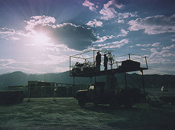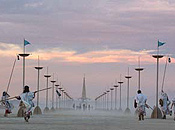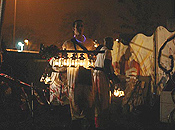In 2004, increasing numbers of Lamplighters stepped into roles of greater responsibility, ensuring that the tradition begun in 1993 of lighting all the major avenues of Black Rock City every night without fail will continue to grow at Burning Man. Our five-member Lamplighter Council consisted of two veterans and three new members. We expanded our volunteer coordinator presence from one to three individuals, a much more appropriate team for the size of our group, and our village and workspace Chapel were consistently full of people eager to get the job done. Probably our most consistent message to our volunteers was to maintain vigilance with the Leave No Trace ethic. With earlier guidance from the Department of Public Works, we maintained and left our cleanest village footprint ever in the Black Rock Desert. This was a significant change over 2003 and was accomplished by diligence, advance planning and constant communication with village participants.
New volunteers got involved early with robe and equipment preparation, community dinner planning, and running our major citywide recruitment parties on the desert. The Lamplighter Sangria Soiree and Bloody Mary Brunch are legendary events at Burning Man, and an entirely new staff approached the management of these traditions with systematic planning that paid off in wonderful events. Most notably, we expanded our use of our Lamplighter Extranet pages to create highly successful interactive pledge tables, which helped us to plan, track, and fill our community dinner menus, and to stock our parties in Black Rock City with supplies and labor. Parade puppet creators used the extranet to document their creative progress.
For the second year in 2004, the Lamplighters rewarded volunteers with a custom necklace charm, but we added participation to the process. Rather than hire out for a designer, Lamplighters submitted charm design sketches, and, with the support of the web team, we polled our membership to select our design for the year.
 A team of workers got together in southern California to design and construct a large-scale art installation for our Lamplighter lounge, the Fountain Fall. The Japanese garden design featured small pools, plants, and faux boulders. The centerpiece of our 2004 lounge, this installation reached up above our shade ceiling! The Fountain Fall was an interactive piece with a perimeter of bench seating and bisected by a curved, rising walkway, with three monolithic beams that met at the top. Water flowed from one beam during the annual Lamplighter Bloody Mary Brunch. Lamplighters and citizens from all over Black Rock City were truly blessed by the extreme generosity and hard work of the Fountain Fall designer and crew!
A team of workers got together in southern California to design and construct a large-scale art installation for our Lamplighter lounge, the Fountain Fall. The Japanese garden design featured small pools, plants, and faux boulders. The centerpiece of our 2004 lounge, this installation reached up above our shade ceiling! The Fountain Fall was an interactive piece with a perimeter of bench seating and bisected by a curved, rising walkway, with three monolithic beams that met at the top. Water flowed from one beam during the annual Lamplighter Bloody Mary Brunch. Lamplighters and citizens from all over Black Rock City were truly blessed by the extreme generosity and hard work of the Fountain Fall designer and crew!
 In her second year of playa operation, the Lamplighter staff vehicle Lucifer received pre-event improvements like steel weld reinforcement, and a canopy was added to shade the volunteers who join our daytime work removing lamps from their spires. Luci was also dispatched to retrieve teams of Lamplighters from their distant lighting route endpoints in Black Rock City, and her raised deck was a crucial aid to the setup crew as a rolling scaffold platform.
In her second year of playa operation, the Lamplighter staff vehicle Lucifer received pre-event improvements like steel weld reinforcement, and a canopy was added to shade the volunteers who join our daytime work removing lamps from their spires. Luci was also dispatched to retrieve teams of Lamplighters from their distant lighting route endpoints in Black Rock City, and her raised deck was a crucial aid to the setup crew as a rolling scaffold platform.
We learned that every route team must carry a radio to keep Luci’s driver informed of their progress and location for transport.
This year we experienced last-minute shortages in setup crews and dinner managers. Old friends returned as unsung guardian angels of our group, working behind the scenes, often in the evenings, to shore up our infrastructure. Many new and sophomore volunteers stepped up with passion and grace, and the DPW and the Volunteer Resource Team sent us some wonderful workers. THANK YOU!!!
 For the first time we formalized a tradition that had grown in the previous four years: to light a major deep-playa installation. In 2004, we were honored to help with The Temple of Stars, and to hear from its designer at our general Lamplighter summer meeting. We added 70 lanterns to our preparation tasks so we could light the temple nightly, and a volunteer supplied his own golf cart to transport temple lanterns and a small lighting crew.
For the first time we formalized a tradition that had grown in the previous four years: to light a major deep-playa installation. In 2004, we were honored to help with The Temple of Stars, and to hear from its designer at our general Lamplighter summer meeting. We added 70 lanterns to our preparation tasks so we could light the temple nightly, and a volunteer supplied his own golf cart to transport temple lanterns and a small lighting crew.
Without diagrams, plans, or many experienced team members and often short of materials, our setup was a challenge. Improvisation was sometimes the only recourse, leading to mixed results. Delays due to rethinking the design of the first village structure, the community kitchen, can be avoided by a back-to-basics approach. Members of our setup crew had the added burden of their own major art installations to manage in addition to their Lamplighter responsibilities. The setup crew should be recruited separately from those who wish to contribute art installations in the future. The spectacular scale of the Fountain Fall project taxed the finances of individuals, the labor force, and the physical infrastructure of our village, as did the construction of an underused lounge stage. Kudos to those who did not want to compromise that’s the Burning Man way but smaller installations would fit better within the village plan.
Early in our event workweek, unclear management roles in our Chapel workspace led to contradictions and confusion among our volunteers. Walk-in volunteers and villagers deserve a positive experience. With many distractions and management unsettled and shuffling, we neglected to educate our volunteers and guide and track some of the basics, the core ritual aspects of what we do.
We reduced our nine-member council from 2003 down to five members, as mentioned, since the larger body proved difficult to manage and bring to consensus. The reduction had its advantages, but it also forced council members to wear many hats, and too often they had to jump from one unfinished task to another, more urgent one. The successes of our dinner and party planning and management, along with the nearly spontaneous rise of new leaders from our volunteer corps, have indicated a course for the future. A small council is good for planning and governing the group, but those few people cannot manage every aspect of our on-site activities. The process of recruiting a new tier of managers began before the end of 2004. Council members will still run the show, managing much of what needs to get done, but many tasks will have the complete, exclusive focus of a proven, capable individual. We expect better results when people can make a task their own. Some Lamplighter facilities will work under more than one manager. The Chapel, for example, needs separate people to work as workflow manager, lighting logistics master, volunteer instructor, and parade manager.
About one-half of our scheduled setup crew were no-shows in 2004, a difficult problem to prevent when we were supplementing our crew with new, unfamiliar recruits. Some failed to arrive due to transportation issues. Future crews will benefit from documentation collected in 2004. Diagrams and plans, especially work schedules and pre-event teleconferencing, should help them prepare and execute their tasks. Spring trips to Black Rock Station will be helpful to sort container inventories when setup pressures are not driving the crew. Our current inventory shows an alarming depletion of new lanterns from 2003. Unattended lanterns lit in the Chapel may need to be secured with cable to insure against attrition, or perhaps Lamplighter chandeliers built from our carry poles will put them out of harm’s way. During the event, the setup crew manager should take advantage of the moral support and advice that can be gained by attending some of the daily Community Service Department meetings.
 With a new, tiered management team in place, we anticipate great possibilities for growth and achievement. Luci has a sturdy, reinforced frame, but she’s still really a skeleton waiting for flesh and skin, and she needs guardians for her continued successful operations in the desert. Parade puppets have been built by our villagers every year and are sometimes joined by giant figures recruited from other villages in BRC, a tradition worth keeping. In the past, Lamplighters have created public art installation piazzas in the heart of our village, a tradition to which we hope to return. Generous volunteers replaced energy gobbling appliances to reduce our power drain. Going off-grid is the long-term objective, with solar panels to power lighting and a fully propane-fueled community kitchen.
With a new, tiered management team in place, we anticipate great possibilities for growth and achievement. Luci has a sturdy, reinforced frame, but she’s still really a skeleton waiting for flesh and skin, and she needs guardians for her continued successful operations in the desert. Parade puppets have been built by our villagers every year and are sometimes joined by giant figures recruited from other villages in BRC, a tradition worth keeping. In the past, Lamplighters have created public art installation piazzas in the heart of our village, a tradition to which we hope to return. Generous volunteers replaced energy gobbling appliances to reduce our power drain. Going off-grid is the long-term objective, with solar panels to power lighting and a fully propane-fueled community kitchen.
The 1999 Lamplighter manual, available to all our team members through our extranet pages, is a great resource for the ritual history, and the practical instruction for robe and equipment construction. Every other aspect of what we do has changed over the years, and it’s time for a major revision to include setup plans and diagrams of the Lamplighter lounge and Chapel, organization for community dinners, and construction of parade puppets, to name a few subjects. Web space is available to collect the wealth of Lamplighter content accumulated since 1993, and the project only needs a volunteer web crew to step in and complete it.
 Our greatest virtue is the devotion of stellar volunteers. Following the first Lamplighter procession at New York’s decompression a few years back, volunteers this year made robes and equipment to light Arizona’s Toast regional burn. Then we jumped the pond: Lamplighters participated in London’s UK Decompression in December. This year, a few sophomore volunteers came back ready to take on more duties and responsibilities. The pattern is set and the gears are turning for it to happen all over again in 2005, on a larger scale, with more focused, new management from our passionate volunteers.
Our greatest virtue is the devotion of stellar volunteers. Following the first Lamplighter procession at New York’s decompression a few years back, volunteers this year made robes and equipment to light Arizona’s Toast regional burn. Then we jumped the pond: Lamplighters participated in London’s UK Decompression in December. This year, a few sophomore volunteers came back ready to take on more duties and responsibilities. The pattern is set and the gears are turning for it to happen all over again in 2005, on a larger scale, with more focused, new management from our passionate volunteers.
Submitted by,
Terry Schoop
2004 Lamplighter Project Manager

